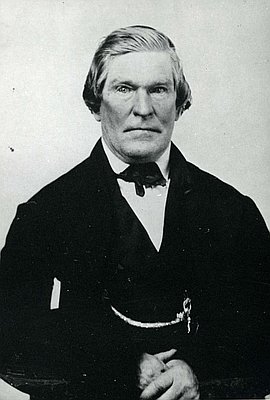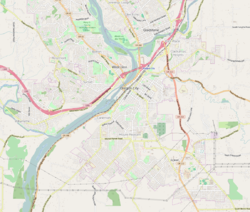
Oregon City is the county seat of Clackamas County, Oregon, United States, located on the Willamette River near the southern limits of the Portland metropolitan area. As of the 2020 census, the city population was 37,572. Established in 1829 by the Hudson's Bay Company, in 1844 it became the first U.S. city west of the Rocky Mountains to be incorporated.

The Willamette River is a major tributary of the Columbia River, accounting for 12 to 15 percent of the Columbia's flow. The Willamette's main stem is 187 miles (301 km) long, lying entirely in northwestern Oregon in the United States. Flowing northward between the Oregon Coast Range and the Cascade Range, the river and its tributaries form the Willamette Valley, a basin that contains two-thirds of Oregon's population, including the state capital, Salem, and the state's largest city, Portland, which surrounds the Willamette's mouth at the Columbia.

Champoeg is a former town in the U.S. state of Oregon. Now a ghost town, it was an important settlement in the Willamette Valley in the early 1840s. Located halfway between Oregon City and Salem, it was the site of the first provisional government of the Oregon Country.

The Broadway Bridge is a Rall-type bascule bridge spanning the Willamette River in Portland, Oregon, United States, built in 1913. It was Portland's first bascule bridge, and it continues to hold the distinction of being the longest span of its bascule design type in the world. It was added to the National Register of Historic Places in November 2012.

Governor Tom McCall Waterfront Park is a 36.59-acre (148,100 m2) park located in downtown Portland, Oregon, along the Willamette River. After the 1974 removal of Harbor Drive, a major milestone in the freeway removal movement, the park was opened to the public in 1978. The park covers 13 tax lots and is owned by the City of Portland. The park was renamed in 1984 to honor Tom McCall, the Oregon governor who pledged his support for the beautification of the west bank of the Willamette River—harkening back to the City Beautiful plans at the turn of the century which envisioned parks and greenways along the river. The park is bordered by RiverPlace to the south, the Steel Bridge to the north, Naito Parkway to the west, and Willamette River to the east. In October 2012, Waterfront Park was voted one of America's ten greatest public spaces by the American Planning Association.

This is a list of properties and historic districts in Oregon that are listed on the National Register of Historic Places. There are listings in all of Oregon's 36 counties.

Philip Foster was one of the first settlers in Oregon, United States. The farmstead he established in Eagle Creek in 1847 became a stopping post for pioneers heading west along the Oregon Trail. Approximately 10,000 emigrants are believed to have passed through. The farm was listed on the National Register of Historic Places in 1980.

The history of the city of Portland, Oregon, began in 1843 when business partners William Overton and Asa Lovejoy filed to claim land on the west bank of the Willamette River in Oregon Country. In 1845 the name of Portland was chosen for this community by coin toss. February 8, 1851, the city was incorporated. Portland has continued to grow in size and population, with the 2010 Census showing 583,776 residents in the city.

Asa Lawrence Lovejoy was an American pioneer and politician in the region that would become the U.S. state of Oregon. He is best remembered as a founder of the city of Portland, Oregon. He was an attorney in Boston, Massachusetts before traveling by land to Oregon; he was a legislator in the Provisional Government of Oregon, mayor of Oregon City, and a general during the Cayuse War that followed the Whitman massacre in 1847. He was also a candidate for Provisional Governor in 1847, before the Oregon Territory was founded, but lost that election.

Francis William Pettygrove was a pioneer and one of the founders of the cities of Portland, Oregon, and Port Townsend, Washington. Born in Maine, he re-located to the Oregon Country in 1843 to establish a store in Oregon City. Later that year he paid $50 for half of a land claim on which he and Asa Lovejoy laid out a town named Portland after the port city in Pettygrove's home state. Lovejoy preferred Boston, but Pettygrove won a coin toss giving him the right to choose the name.

The Francis Marion Stokes Fourplex is a historic residential building located in the Northwest district of Portland, Oregon, United States.
The Oregon Lyceum or Pioneer Lyceum and Literary Club was founded in Oregon City, Oregon Country around 1840. The forum was a prominent fixture for the leading pioneer settlers during its brief existence. It would begin publishing the first American newspaper west of the Rocky Mountains in 1846 and had several names during its existence.

The Provisional Legislature of Oregon was the single-chamber legislative body of the Provisional Government of Oregon. It served the Oregon Country of the Pacific Northwest of North America from 1843 until early 1849 at a time when no country had sovereignty over the region. This democratically elected legislature became the Oregon Territorial Legislature when the territorial authorities arrived after the creation of the Oregon Territory by the United States in 1848. The body was first termed the Legislative Committee and later renamed the House of Representatives. Over the course of its six-year history the legislature passed laws, including taxation and liquor regulation, and created an army to deal with conflicts with Native Americans.
William Overton was a pioneer of the Oregon Country in the Pacific Northwest region of North America. In the mid-1840s he purchased the land claim, along with Asa Lovejoy, for the site which would become Portland, Oregon. Overton sold his share shortly thereafter to Francis Pettygrove.

The Portland Penny is the name subsequently given to a specific copper matron head one-cent coin, used to decide the name of Portland, Oregon, United States.
John Lindsey Morrison arrived in Oregon Country in 1842 along with other famous Oregon pioneers Medorem Crawford, Asa Lovejoy, and Sidney Moss, in the same wagon train. Morrison built the home of Francis Pettygrove in early Portland, Oregon, in 1846. The street on which Pettygrove's house was located was named in honor of Morrison. The first Morrison Street Bridge, crossing the Willamette River into East Portland, has been said to be named after Morrison, but alternatively it has been stated that the bridge simply took the name of the street that had been named for Morrison.

Pettygrove Park is a city park in downtown Portland, Oregon, United States. It is the second park in a series of urban open spaces designed by American landscape architect Lawrence Halprin in the South Auditorium District urban renewal area. The soft mounds of landscaping are responsible for the park's nickname of 'Mae West Park'.

Southwest Portland is one of the sextants of Portland, Oregon.




















